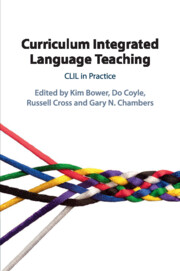Book contents
- Curriculum Integrated Language Teaching
- Curriculum Integrated Language Teaching
- Copyright page
- Contents
- Figures
- Tables
- Contributors
- Foreword
- Preface
- Acknowledgements
- Part I The Educational Context for CLIL
- Part II Current Aspects of Practice in CLIL
- Part III New Knowledge and Future Directions
- 8 Lessons to Be Learned
- 9 Supporting Peer Collaboration and Social Cohesion in Multilingual Classrooms
- 10 Exploring the Potential of a Pluriliteracies Approach
- Afterword
- Index
- References
10 - Exploring the Potential of a Pluriliteracies Approach
from Part III - New Knowledge and Future Directions
Published online by Cambridge University Press: 27 July 2020
- Curriculum Integrated Language Teaching
- Curriculum Integrated Language Teaching
- Copyright page
- Contents
- Figures
- Tables
- Contributors
- Foreword
- Preface
- Acknowledgements
- Part I The Educational Context for CLIL
- Part II Current Aspects of Practice in CLIL
- Part III New Knowledge and Future Directions
- 8 Lessons to Be Learned
- 9 Supporting Peer Collaboration and Social Cohesion in Multilingual Classrooms
- 10 Exploring the Potential of a Pluriliteracies Approach
- Afterword
- Index
- References
Summary
This chapter focuses on current thinking around the concept of pluriliteracies as an ‘ecological growth model’ for learning and its potential for enriching classrooms into sites of deeper integrated learning. This resonates with more recent interest in the role of literacies in the field of CLIL pedagogy, which, according to Morton (2018: 56), ‘adds a focus on subject-specific literacy to that of content and language’. Dalton-Puffer (2014) suggests that given the wide range of theoretical perspectives associated with bilingual learning, there is a need to openly address ‘objectively unresolvable debates’. However although such positive positioning moves thinking forward, it is not enough. Instead, Van Lier (2010) advocates a more ecological perspective to overcome conflicts between theoretical positioning and practical positioning. The chapter explores ways in which pluriliteracies can be embedded in learner-driven pedagogies, which are socially inclusive and potentially transformative and redefine ‘successful learning’, across the curriculum.
Information
- Type
- Chapter
- Information
- Curriculum Integrated Language TeachingCLIL in Practice, pp. 187 - 204Publisher: Cambridge University PressPrint publication year: 2020
References
Accessibility standard: Unknown
Why this information is here
This section outlines the accessibility features of this content - including support for screen readers, full keyboard navigation and high-contrast display options. This may not be relevant for you.Accessibility Information
- 2
- Cited by
